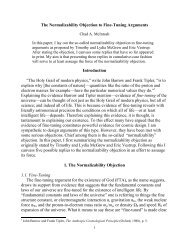Theism and Explanation - Appeared-to-Blogly
Theism and Explanation - Appeared-to-Blogly
Theism and Explanation - Appeared-to-Blogly
You also want an ePaper? Increase the reach of your titles
YUMPU automatically turns print PDFs into web optimized ePapers that Google loves.
Appendix 155<br />
Will this suffi ce as a description of an intentional explanation? It suffers<br />
from two weaknesses. The fi rst lies in its fi rst premise, which states merely<br />
that the agent has a desire for . I have already argued that having a desire<br />
is not the same as having an intention. The second is that this syllogism<br />
moves from two facts about the agent <strong>to</strong> a conclusion about what the agent<br />
“should” do. Even if we can clarify what it means <strong>to</strong> say that the agent<br />
“should” perform action A—in the sense that this is the most reasonable<br />
way for her <strong>to</strong> act—what we are wanting <strong>to</strong> explain is the agent’s action.<br />
So ideally our conclusion should describe the action itself, while making it<br />
clear how it fl ows from the premises.<br />
Georg Henrik von Wright offers us a form of practical syllogism that<br />
addresses both of these issues.<br />
(1) A intends <strong>to</strong> bring about p.<br />
(2) A considers that he cannot bring about p unless he does a.<br />
(3) Therefore A sets himself <strong>to</strong> do a. 39<br />
Note how this differs from Audi’s schema. The initial premise now posits<br />
an intention rather than a mere desire, while the conclusion is a statement<br />
about the performance of the action in question. It does not merely state<br />
that it is what the agent ought <strong>to</strong> do. Will this suffi ce as an explanation of<br />
an action? It may be better than Audi’s schema, but it still fails <strong>to</strong> make it<br />
clear how the action in question follows from the premises. Its conclusion<br />
is introduced by a “therefore,” but what lies behind this “therefore” is not<br />
made explicit. So my preferred form of practical syllogism is the one I outlined<br />
earlier (4.4.3).<br />
(1) There exists a rational agent A with intended goal G.<br />
(2) A has beliefs B 1 , B 2 , . . . B n relating <strong>to</strong> the attainment of G.<br />
(3) If B 1 , B 2 , . . . B n were true, E would be the best way of achieving G.<br />
(4) Rational agents always choose the best way of achieving their goals.<br />
(5) Therefore A will do E.<br />
This introduces in<strong>to</strong> the discussion the rationality principle upon which, I<br />
have argued, all intentional explanations rest. And it is this rationality principle<br />
which makes explicit the rationale behind the “should A” of Audi’s<br />
formulation <strong>and</strong> the “therefore” that introduces von Wright’s conclusion.<br />
A.2.2 Explaining the Explanans<br />
On the assumption that an explanation can be complete even if it does not<br />
explain its explanans (1.3.3), then the above syllogism represents an intentional<br />
explanation. Such an explanation posits an agent having a particular<br />
intention, along with a set of relevant beliefs, <strong>and</strong> shows the explan<strong>and</strong>um<br />
is how we would expect such an agent <strong>to</strong> act. But we may, of course, ask a



